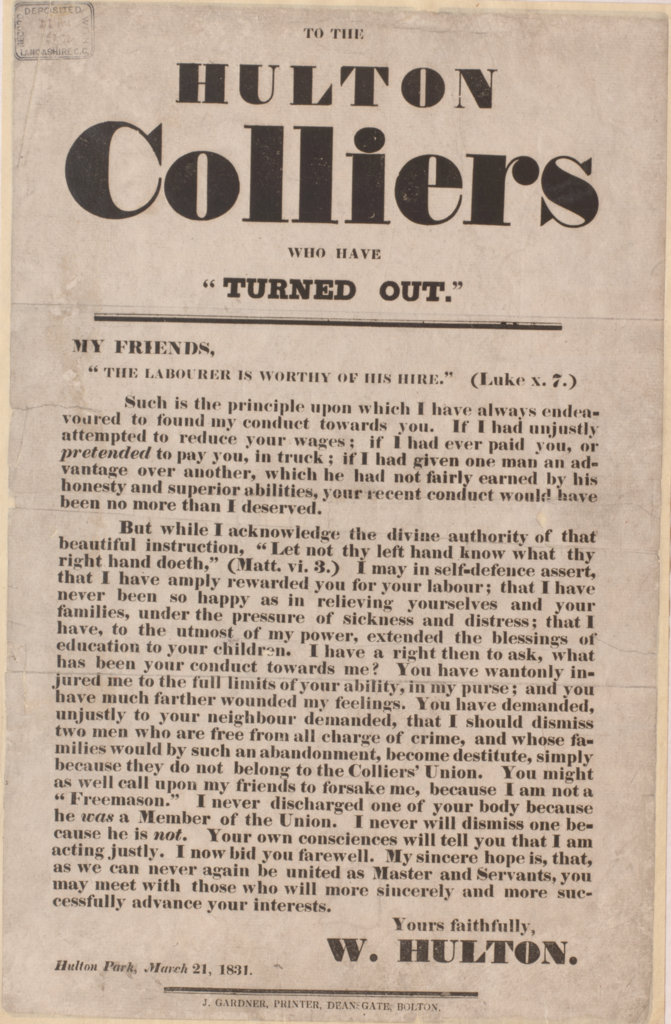The Hulton Colliery Company operated from the mid-19th century on the Lancashire Coalfield in Over Hulton and Westhoughton, Lancashire. Its coal reserves underlay the Hulton Park estate, which had been owned by the same family since medieval times. In the 19th century William HultonLandowner who lived at Hulton Hall in Lancashire, notorious for his part in the Peterloo Massacre. , who promoted the Bolton and Leigh RailwayLancashire's first public railway, promoted as a mineral line in connection with William Hulton's coal pits to the west of his estate at Over Hulton. , was instrumental in paying low wages and frustrating efforts to form trade unions.
The Hulton Colliery Company was established by William Hulton and Harwood Walcot Banner in 1858, but it was in the Hulton family’s ownership when William’s son became sole owner in 1868 and was sold the following year. The company’s Chequerbent, Klondyke and Pretoria Pits, sunk after 1892, were major employers; an explosion at the Pretoria Pit in 1910 was the third worst in Britain.
Background
The Hulton Colliery Company’s origins were in the shallow coal pits sunk on the northern part of Hulton Park in 1571. The estate was owned by the Hultons, who had held the estate from medieval times. In the early 19th century the pits were owned by William Hulton.[1] His pits thrived and in the 1820s he was instrumental in promoting the Bolton and Leigh Railway. By 1840 pits had been sunk to the north of the Manchester to Preston road (A6) and west of the Bolton to Leigh road (A579) and Hulton Lane.[2]
In 1843 Hulton reportedly paid his colliers the poorest wages in Lancashire. He was opposed to permitting the right to free assembly and was vehemently opposed to miners congregating with the object of forming a union.[3]
Company
Hulton established the Hulton Colliery Company with a partner, Harwood Walcot Banner, in 1858. After Hulton’s death in 1864 his son, William Ford Hulton succeeded him and became the sole owner in 1868 when the partnership was dissolved. The company sank pits near Chequerbent. The Arley Pits and the School Pit were sunk north of the Manchester road and older workings were abandoned. The new pits were linked to the Bolton and Leigh Railway line at Pendlebury Fold where the company had built brickworks.[4]
William Ford Hulton died in 1879 and was succeeded by William W. B. Hulton who sold his mining rights to the Hulton Colliery Company Ltd. The company expanded, and sank the shafts for the Chequerbent Pits to the east of the railway line and south of the Manchester road in 1892.[5]
The shafts of Hulton Colliery’s Bank Pit Nos 1&2, known locally as the Klondike Pit, were sunk in 1897 south of Chequerbent Colliery and Bank Pit Nos 3&4 shafts, the Pretoria Pit, were sunk between 1900 and 1901 close to the Atherton boundary towards the south-west corner of the estate.[6] On 21 December 1910 an explosion of firedamp at Hulton No. 3 Pretoria Pit killed 344 men. It was the second worst mining accident in England, and the third worst in Britain.[7]
The company began sinking shafts for Cronton Colliery between Widnes and Prescot in 1913 and in 1916 they had reached 520 yards (475 m). Its coal winding shaft intersected the Plodder, Wigan Four Feet, Lower Florida, Pigeon House and Rushy Park mine, all of which were worked. The colliery was nationalised in 1947 and closed in 1984.[8]

